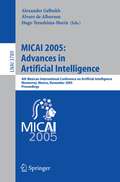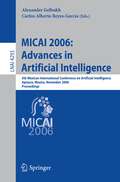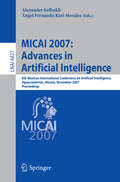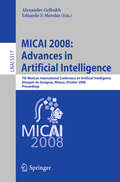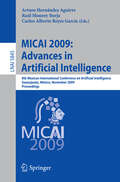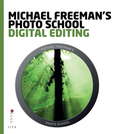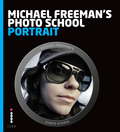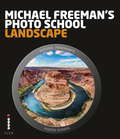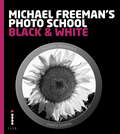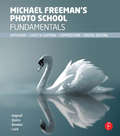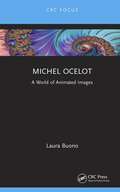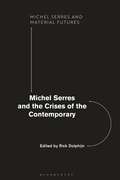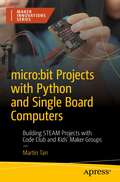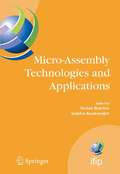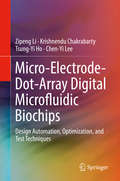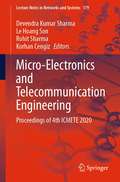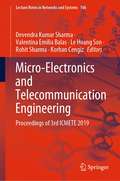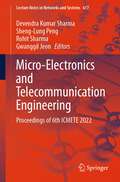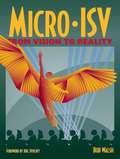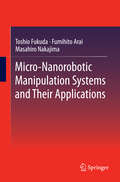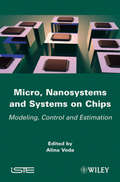- Table View
- List View
MICAI 2005: 4th Mexican International Conference on Artificial Intelligence, Monterrey, Mexico, November 14-18, 2005, Proceedings (Lecture Notes in Computer Science #3789)
by Alexander Gelbukh Hugo TerashimaMICAI 2006: 5th Mexican International Conference on Artificial Intelligence, Apizaco, Mexico, November 13-17, 2006, Proceedings (Lecture Notes in Computer Science #4293)
by Alexander Gelbukh Carlos Alberto Reyes-GarciaThis book constitutes the refereed proceedings of the 5th Mexican International Conference on Artificial Intelligence, MICAI 2006, held in Apizaco, Mexico in November 2006. It contains over 120 papers that address such topics as knowledge representation and reasoning, machine learning and feature selection, knowledge discovery, computer vision, image processing and image retrieval, robotics, as well as bioinformatics and medical applications.
MICAI 2007: 6th Mexican International Conference on Artificial Intelligence, Aguascalientes, Mexico, November 4-10, 2007, Proceedings (Lecture Notes in Computer Science #4827)
by Alexander Gelbukh Àngel Fernando Kuri MoralesThis book constitutes the refereed proceedings of the 6th Mexican International Conference on Artificial Intelligence, MICAI 2007, held in Aguascalientes, Mexico, in November 2007. The 116 revised full papers presented were carefully reviewed and selected from numerous submissions for inclusion in the book. The papers are organized in sections on topics that include computational intelligence, neural networks, knowledge representation and reasoning, agents and multiagent systems.
MICAI 2008: 7th Mexican International Conference on Artificial Intelligence, Atizapán de Zaragoza, Mexico, October 27-31, 2008 Proceedings (Lecture Notes in Computer Science #5317)
by Alexander Gelbukh Eduardo F. MoralesThe Mexican International Conference on Artificial Intelligence (MICAI), a yearly international conference series organized by the Mexican Society for Artificial Intel- gence (SMIA), is a major international AI forum and the main event in the academic life of the country’s growing AI community. In 2008 Mexico celebrates the 50th an- versary of development of computer science in the country: in 1958 the first computer was installed at the National Autonomous University of Mexico (UNAM). Nowadays, computer science is the country’s fastest growing research area. The proceedings of the previous MICAI events were published by Springer in its Lecture Notes in Artificial Intelligence (LNAI) series, vol. 1793, 2313, 2972, 3789, 4293, and 4827. Since its foundation in 2000, the conference has been growing in popularity, and improving in quality. This volume contains the papers presented at the oral session of the 7th Mexican International Conference on Artificial Intelligence, MICAI 2008, held October 27–31, 2008, in Atizapán de Zaragoza, Mexico. The conference received for evaluation 363 submissions by 1,032 authors from 43 countries (see Tables 1 and 2). This volume contains revised versions of 94 papers by 308 authors from 28 countries selected - cording to the results of an international reviewing process. Thus the acceptance rate was 25.9%. The book is structured into 20 thematic fields representative of the main current areas of interest for the AI community, plus a section of invited papers:
MICAI 2009: 8th Mexican International Conference on Artificial Intelligence, Guanajuato, México, November 9-13, 2009 Proceedings (Lecture Notes in Computer Science #5845)
by Arturo Hernández Aguirre Raúl Monroy Borja Carlos Albetro Reyes GarcíaMichael Freeman's Photo School: Essential Aspects of Digital Editing (Michael Freeman's Photo School)
by Michael FreemanUnlock the full potential of each and every image with reliable post-production techniques that will become a fundamental part of your photography. Using easily followed, step-by-step instructions, Michael Freeman demystifies the complexities of today's high-powered editing programs to provide you with effective digital workflows tailored to your particular photographic style, and using whichever editing programs you are most comfortable with.Begin by exploring the fundamental aspects of image optimisation, from fixing exposure and making colour adjustments, to sharpening and noise reduction - essential steps that elevate simple snapshots to stunning images. Then move on to explore the advanced possibilities of black-and-white conversion, panoramic stitching, HDR imaging, and more. Learn to recognise the right tools for the job, saving you time on the computer and ensuring each image gets the treatment it deserves.Whether you're salvaging an underexposed shot or building a composite of multiple images, these techniques will give your photography a professional and refined style.
Michael Freeman's Photo School: Essential Aspects of Quality Portraiture (Michael Freeman's Photo School)
by Michael FreemanAt some point, all photographers are called upon to shoot a proper portrait - combining technical skill with personable demeanour to capture someone in their best possible light. Michael Freeman teaches you how to achieve flattering portrait results with a variety of both traditional and modern styles.Learn how to set your subjects at ease and bring out their natural beauty with a friendly yet professional attitude. Feel confident giving directions on posing and stance with a thorough review of the classic approaches, from head-and-shoulder shots to full-length compositions, and everything in between.Take creative control of your portrait sessions by learning to manipulate the light to your own ends - whether that means bouncing sunlight o a reflector or building your own studio setups with multiple fl ash units. The complex science of photographic lighting is explained in straightforward and easy-to-understand language, with abundant and inspirational examples. Finally, master the fundamentals of post-production finishing techniques to make sure every portrait looks its absolute best. Your subjects will thank you for it!
Michael Freeman's Photo School: Essential Aspects of Landscape Photography (Michael Freeman's Photo School)
by Michael FreemanThe classic genre that has been a fundamental part of photography since the beginning, landscape has perennial appeal to all photographers. Michael Freeman shares his wealth of experience in this comprehensive guide to art of capturing beautiful landscapes.Start your exploration of this vast subject by deconstructing and studying its elements-from the most reliable locations to the classic compositions. Next, learn how to find and position yourself in the optimal viewpoints for original and creative interpretations of these massive subjects. Using the right gear and techniques for each frame, you will be able to capture depth and dimensionality that speak to the grandeur of these exotic locations. With the sky as your studio, you can make the weather work for you to provide a stunning variety of spectacular light.Going beyond the purely technical side, Freeman also dives into the mind of the landscape photographer, addressing the environment, studying how distinct colour palettes can evoke moods, and following in the illustrious tradition of B&W landscapes. The studio will start to feel very small indeed once you start exploring the great outdoors!
Michael Freeman's Photo School: Mastering the Craft of Black-and-White Photography with a Unique Approach (Michael Freeman's Photo School)
by Michael FreemanFrom timeless, elegant portraits to gritty, graphic street shots, the possibilities of black and white are endless, enticing, and exciting. Recognising this potential within every shot, and knowing the digital-editing tools and techniques to maximize its effect are essential steps to building up your photographic repertoire.Having first established the fundamental aesthetic choices that go into every B&W conversion, Michael Freeman goes on to review the noble tradition of black and white, detailing its numerous styles and fashions, with step-by-step instructions on how to achieve each effect, regardless of your particular software. Presented in a straightforward and easy-to-understand format, you will soon be able to both visualise exactly how you want your final image to appear, and achieve that signature look with efficient workflows and powerful conversion techniques.These skills open up new worlds of photographic opportunity everywhere you look, and encourage artistic growth just as much as they inspire you to try new styles and exciting treatments.
Michael Freeman's Photo School Fundamentals: Exposure, Light & Lighting, Composition
by Michael FreemanPhotography is international best-seller Michael Freeman’s life, and in this book he works together with fellow photography experts to share his and their knowledge with anyone who wants to learn not only how to take better photos, but also why those photographs work and where they fit in with the history of the craft. Inspired by the structure of a college course and the benefits of a collective learning environment, this book teaches the fundamentals of photography not just through comprehensive lessons and instructions, but also through challenges in which readers can participate. Sample work from Michael’s students provides inspiration, and critical evaluations of the results ensure that the core concepts are being grasped every step of the way. Additionally, readers can join in by sharing their work via the series’ dedicated website.
Michael Freeman's Photo School Fundamentals: Exposure, Light & Lighting, Composition
by Michael FreemanPhotography is international best-seller Michael Freeman’s life, and in this book he works together with fellow photography experts to share his and their knowledge with anyone who wants to learn not only how to take better photos, but also why those photographs work and where they fit in with the history of the craft. Inspired by the structure of a college course and the benefits of a collective learning environment, this book teaches the fundamentals of photography not just through comprehensive lessons and instructions, but also through challenges in which readers can participate. Sample work from Michael’s students provides inspiration, and critical evaluations of the results ensure that the core concepts are being grasped every step of the way. Additionally, readers can join in by sharing their work via the series’ dedicated website.
Michel Ocelot: A World of Animated Images
by Laura BuonoThis unique book examines the career of Michel Ocelot, from his earliest works to his latest research and productions, including an interview regarding his latest film Le Pharaon, le Sauvage et la Princesse (2022). The book highlights the director’s role in the panorama of contemporary animated cinema and his relationship with the tradition, both artistic and cinematographic. The book carefully analyses the ethical and social nature of Ocelot’s work to underscore the duality of the director’s oeuvre, both artistic and social, using an interdisciplinary approach that blends film and aesthetic criticism with gender studies and decolonial thought. Particular attention will be given to the themes of multiculturalism, discrimination, and treatment of women, which are at the centre of many current cultural debates. The book will be of interest to an audience of experts, animation enthusiasts, and film scholars, as well as to a wider readership interested in learning about the poetics of Kirikou’s father.
Michel Ocelot: A World of Animated Images
by Laura BuonoThis unique book examines the career of Michel Ocelot, from his earliest works to his latest research and productions, including an interview regarding his latest film Le Pharaon, le Sauvage et la Princesse (2022). The book highlights the director’s role in the panorama of contemporary animated cinema and his relationship with the tradition, both artistic and cinematographic. The book carefully analyses the ethical and social nature of Ocelot’s work to underscore the duality of the director’s oeuvre, both artistic and social, using an interdisciplinary approach that blends film and aesthetic criticism with gender studies and decolonial thought. Particular attention will be given to the themes of multiculturalism, discrimination, and treatment of women, which are at the centre of many current cultural debates. The book will be of interest to an audience of experts, animation enthusiasts, and film scholars, as well as to a wider readership interested in learning about the poetics of Kirikou’s father.
Michel Serres and the Crises of the Contemporary (Michel Serres and Material Futures)
by Rick DolphijnMichel Serres captures the urgencies of our time; from the digital revolution to the ecological crisis to the future of the university, the crises that code the world today are addressed in an accessible, affirmative and remarkably original analysis in his thought.This volume is the first to engage with the philosophy of Michel Serres, not by writing 'about' it, but by writing 'with' it. This is done by expanding upon the urgent themes that Serres works on; by furthering his materialism, his emphasis on communication and information, his focus on the senses, and the role of mathematics in thought. His famous concepts, such as the parasite, 'amis de viellesse', and the algorithm are applied in 21st century situations. With contributions from an international and interdisciplinary team of authors, these writings tackle the crises of today and affirm the contemporary relevance of Serres' philosophy.
Michel Serres and the Crises of the Contemporary (Michel Serres and Material Futures)
by Rick DolphijnMichel Serres captures the urgencies of our time; from the digital revolution to the ecological crisis to the future of the university, the crises that code the world today are addressed in an accessible, affirmative and remarkably original analysis in his thought.This volume is the first to engage with the philosophy of Michel Serres, not by writing 'about' it, but by writing 'with' it. This is done by expanding upon the urgent themes that Serres works on; by furthering his materialism, his emphasis on communication and information, his focus on the senses, and the role of mathematics in thought. His famous concepts, such as the parasite, 'amis de viellesse', and the algorithm are applied in 21st century situations. With contributions from an international and interdisciplinary team of authors, these writings tackle the crises of today and affirm the contemporary relevance of Serres' philosophy.
micro: Building STEAM Projects with Code Club and Kids' Maker Groups
by Martin TanBuild different components of larger systems using class sets of micro:bits with Python in a truly collaborative way. First you’ll explore ways to harness the capabilities of the humble micro:bit and learn to creatively overcome some of its limitations; learning practical text-based programming along the way. We’ll then move on to building projects that allow multiple micro:bits, and other microcontroller boards and parts like the Raspberry Pi, to communicate with one another, and coordinate their operations to build larger systems.Rather than just being a guide to learning these skills, this book will include tips and stories about implementing the these ideas in classrooms, Code Clubs, and Maker environments. Practical logistics for preparation and easy set-up, as well as, acceptance criteria and accountability for students and participants is included. These ideas were gained over years of running a Code Club and running Maker workshops and events.You’ll learn about programming collaborative solutions and design logic. Then you’ll scale that logic up to more complex projects. By the end, you’ll have added additional electronic and physical components to projects that interact with the world. You’ll create fun inventions together, using hardware, coding, electronics, physical objects, and e-textiles.What You'll LearnSolve problems and create art by modelling solutions and ideas with a combination of Python coding, electronic systems engineering, and creative design.Navigate the logistical and unique challenges that come with running your own Code Club, Makerspace, or feeding these activities into STEAM design and technology curriculums.Take new Makers from simply copying and duplicating through to debugging and understanding.Who This Book Is ForMakers and instructors interested in starting group projects while learning to code and gain other Maker skills along the way. Essential information is provided in a form that enables beginners and intermediate Makers to get hands-on quickly, but with enough depth to keep building on these projects and pushing the boundaries.
Micro-Assembly Technologies and Applications: IFIP TC5 WG5.5 Fourth International Precision Assembly Seminar (IPAS'2008) Chamonix, France, February 10-13, 2008 (IFIP Advances in Information and Communication Technology #260)
by Sandra KoelemeijerMicro-assembly is a key enabling technology for cost effective manufacture of new generations of complex micro products. It is also a critical technology for retaining mdustrial capabilities in high labour cost areas such as Europe since up to 80% of the production cost in some industries is attributed directly to assembly processes. With the continuous trend for product miniaturisation, the scientific and technologi cal developments in micro-assembly are expected to have a significant long-term economic, demographic and social impact. A distinctive feature of the process is that surface forces are often dominant over gravity forces, which determines a number of specific technical challenges. Critical areas which are currently being addressed include development of assembly systems with high positional accuracy, micro gripping methods that take into ac count the adhesive surface forces, high precision micro-feeding techniques and mi cro-joining processes. Micro-assembly has developed rapidly over the last few years and all the pre dictions are that it will remain a critical technology for high value products in a number of key sectors such as healthcare, communications, defence and aerospace. The key challenge is to match the significant technological developments with a new generation of micro products that will establish firmly micro-assembly as a core manufacturing process.
Micro-Electrode-Dot-Array Digital Microfluidic Biochips: Design Automation, Optimization, And Test Techniques
by Zipeng Li Krishnendu Chakrabarty Tsung-Yi Ho Chen-Yi LeeThis book provides an insightful guide to the design, testing and optimization of micro-electrode-dot-array (MEDA) digital microfluidic biochips. The authors focus on the characteristics specific for MEDA biochips, e.g., real-time sensing and advanced microfluidic operations like lamination mixing and droplet shape morphing. Readers will be enabled to enhance the automated design and use of MEDA and to develop a set of solutions to facilitate the full exploitation of design complexities that are possible with standard CMOS fabrication techniques. The book provides the first set of design automation and test techniques for MEDA biochips. The methods described in this book have been validated using fabricated MEDA biochips in the laboratory. Readers will benefit from an in-depth look at the MEDA platform and how to combine microfluidics with software, e.g., applying biomolecular protocols to software-controlled and cyberphysical microfluidic biochips.
Micro-Electronics and Telecommunication Engineering: Proceedings of 4th ICMETE 2020 (Lecture Notes in Networks and Systems #179)
by Devendra Kumar Sharma Le Hoang Son Rohit Sharma Korhan CengizThis book presents selected papers from the 4th International Conference on Micro-Electronics and Telecommunication Engineering, held at SRM Institute of Science and Technology, Ghaziabad, India, during 26–27 September 2020. It covers a wide variety of topics in micro-electronics and telecommunication engineering, including micro-electronic engineering, computational remote sensing, computer science and intelligent systems, signal and image processing, and information and communication technology.
Micro-Electronics and Telecommunication Engineering: Proceedings of 3rd ICMETE 2019 (Lecture Notes in Networks and Systems #106)
by Rohit Sharma Valentina Emilia Balas Devendra Kumar Sharma Le Hoang Son Korhan CengizThis book presents selected papers from the 3rd International Conference on Micro-Electronics and Telecommunication Engineering, held at SRM Institute of Science and Technology, Ghaziabad, India, on 30-31 August 2019. It covers a wide variety of topics in micro-electronics and telecommunication engineering, including micro-electronic engineering, computational remote sensing, computer science and intelligent systems, signal and image processing, and information and communication technology.
Micro-Electronics and Telecommunication Engineering: Proceedings of 6th ICMETE 2022 (Lecture Notes in Networks and Systems #617)
by Rohit Sharma Sheng-Lung Peng Devendra Kumar Sharma Gwanggil JeonThe book presents high-quality papers from the Sixth International Conference on Microelectronics and Telecommunication Engineering (ICMETE 2022). It discusses the latest technological trends and advances in major research areas such as microelectronics, wireless communications, optical communication, signal processing, image processing, big data, cloud computing, artificial intelligence, and sensor network applications. This book includes the contributions of national and international scientists, researchers, and engineers from both academia and the industry. The contents of this book are useful to researchers, professionals, and students alike.
Micro-ISV: From Vision to Reality
by Robert Walsh*Uniquely and squarely focuses on the needs of a startup ISV *Several leading companies in their market segment are actually micro-ISVs, including Fog Creek (FogBugz) and Sun Belt Software (Counter-Spy). It’s possible to be small AND successful, and this book is perfect for those who wish to try *Volume of Micro ISVs is increasing, signifying a deep, broad audience for this book
Micro-Nanorobotic Manipulation Systems and Their Applications
by Toshio Fukuda Fumihito Arai Masahiro NakajimaMicro/Nano Robotics and Automation technologies have rapidly grown associated with the growth of Micro and Nanotechnologies. This book presents a summary of fundamentals in micro-nano scale engineering and the current state of the art of these technologies.“Micro-Nanorobotic Manipulation Systems and their Applications” introduces these advanced technologies from the basics and applications aspects of Micro/Nano-Robotics and Automation from the prospective micro/nano-scale manipulation. The book is organized in 9 chapters including an overview chapter of Micro/Nanorobotics and Automation technology from the historical view and important related research works. Further chapters are devoted to the physics of micro-nano fields as well as to material and science, microscopes, fabrication technology, importance of biological cell, and control techniques. Furthermore important examples, applications and a concise summary of Micro-Nanorobotics and Automation technologies are given.
Micro, Nanosystems and Systems on Chips: Modeling, Control, and Estimation (Iste Ser.)
by Alina VodaMicro and nanosystems represent a major scientific and technological challenge, with actual and potential applications in almost all fields of the human activity. The aim of the present book is to present how concepts from dynamical control systems (modeling, estimation, observation, identification, feedback control) can be adapted and applied to the development of original very small-scale systems and of their human interfaces. The application fields presented here come from micro and nanorobotics, biochips, near-field microscopy (AFM and STM) and nanosystems networks. Alina Voda has drawn contributions from leading experts at top research universities in France to produce a first overview of the major role that control systems science can play in the development of micro and nanosciences and technologies.
Micro, Nanosystems and Systems on Chips: Modeling, Control, and Estimation
by Alina VodaMicro and nanosystems represent a major scientific and technological challenge, with actual and potential applications in almost all fields of the human activity. The aim of the present book is to present how concepts from dynamical control systems (modeling, estimation, observation, identification, feedback control) can be adapted and applied to the development of original very small-scale systems and of their human interfaces. The application fields presented here come from micro and nanorobotics, biochips, near-field microscopy (AFM and STM) and nanosystems networks. Alina Voda has drawn contributions from leading experts at top research universities in France to produce a first overview of the major role that control systems science can play in the development of micro and nanosciences and technologies.
